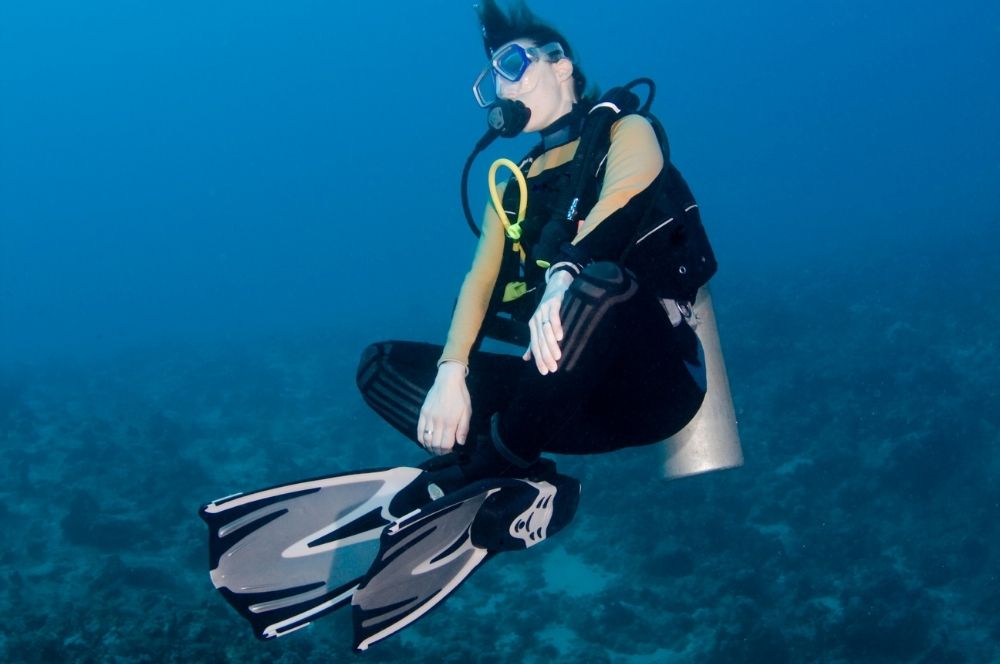You have 0 product(s) in your cart.
Abyss Scuba Diving

Bouyancy Control
Buoyancy control one of the most important skills to master as a scuba diver, and probably one of the hardest ones to master. Once you get your buoyancy right, you will use up less air. You'll feel more comfortable underneath the water, and you'll see more marine life because you won't be so intimidating, flapping around when you get to them.
Mastering Excellent Buoyancy
The first thing that needs to understand is every time you change your gear; your buoyancy will change. So it is quite hard if you're using rental gear at the very beginning, especially the wetsuit, to get the buoyancy right, but always do a buoyancy check before every dive. We need to jump into the water with all the gear that we're going to dive on and hold our breath, a normal breath, and we want to be floating at eye level with no air in our BCDs. Once we've got that right, inflate your BCD, get comfortable, and get ready to deflate to go underneath for a dive.
Once you deflate the air out of your BCD to start your dive, let all the air out of your lungs, and you will start to sink. Once you sink underneath the water, turn down, put your feet up and start to kick yourself down.
Over Weighting
If you are deflating your BCD and sinking like a stone, you are too heavy. And yes, it makes it easy to get underneath the water, and I have people say to me, “I'd rather have too much weight than not enough”, but the problem with it is when you go underneath the water, your wetsuit compresses. It becomes less buoyant. You need to add air to your BCD.
Now, that's fine if you're staying at the same depth, but then you swim up over a rock, and the air in your BCD expands, and you start to float up, so you have to let the air out. Then you come back down again, and you need to put the air back in again, and you're constantly having to add air or take the air out. Realistically, it should be a little bit tricky to get underneath the water.
Once you're at that eight-meter mark, if you're still having to add air to your BCD, you are probably too heavy. Your wetsuit hasn't compressed enough at eight meters for you to need to add air to compensate for that wetsuit compressing, so that's something to think about.
Compensating For Depth
If you can get to eight meters and do a thin pivot, something we learn in the Learn to Dive course, laying on the bottom and taking big, long, deep breaths, you can get your buoyancy around eight meters without having to add any air into your BCD, so exaggerating your breathing, and you can lift up and go back down, your weighting is probably right.
Once you go down past the eight-meter mark, your wetsuit compresses, and you add tiny bits of air as you get deeper. Then when you come back up, you let that air out in tiny bits. But I guess the biggest tip I can give you is that it should be a little tricky to get underneath the water in that you shouldn't have to add air to your BCD in shallower than eight meters of water. If you're doing both of them, you're doing really, really well. Okay? Once you get a little bit deeper, you do have to add air, and as you go deeper, you'll add more air and more air. And then when you come shallower, you need to let that air out.
Buoyancy control is a skill. It needs to be worked on, but once you've got it, it'll be the closest thing you've ever got to walk on the moon unless you're a billionaire. It's pretty amazing when you can be under there going for a dive, and take a big breath in and go up and take a little breath out. You want to go down and see that weedy sea dragon, and just go down and have a look at the weedy sea dragon without crushing or falling on top of it.
So, as I said, it is a skill. It does take a bit of practice. A good way to get some help with it is by doing the PADI Peak Performance Buoyancy course, or coming on in and having a chat with me. I'll help you in the store. Or even if I'm on a shore dive with you next time or a boat dive, have a chat with me, and I can help you prior to the dive with a buoyancy check. And then, during the dive, I'll have a look at you and see what's going on, and then give you some advice after the dive. Buoyancy is one of the most important skills. Get out there and practice it. All it is is practice. Once you get it, you've got it, and it's the most amazing way to dive when you're neutrally buoyant.
Recent Posts





